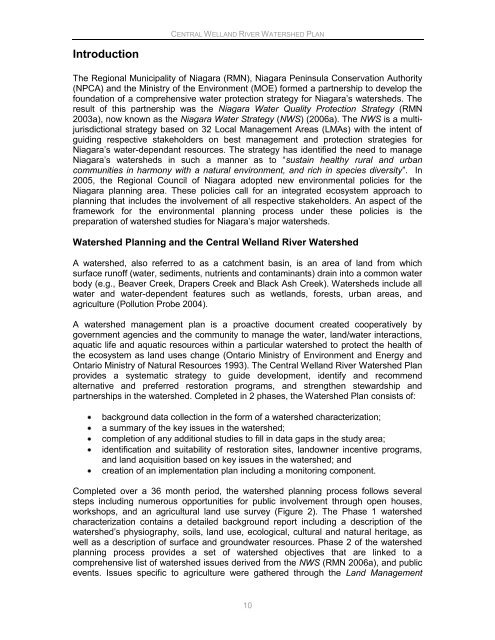Central Welland River Watershed Plan - Niagara Peninsula ...
Central Welland River Watershed Plan - Niagara Peninsula ...
Central Welland River Watershed Plan - Niagara Peninsula ...
- No tags were found...
You also want an ePaper? Increase the reach of your titles
YUMPU automatically turns print PDFs into web optimized ePapers that Google loves.
CENTRAL WELLAND RIVER WATERSHED PLANIntroductionThe Regional Municipality of <strong>Niagara</strong> (RMN), <strong>Niagara</strong> <strong>Peninsula</strong> Conservation Authority(NPCA) and the Ministry of the Environment (MOE) formed a partnership to develop thefoundation of a comprehensive water protection strategy for <strong>Niagara</strong>‟s watersheds. Theresult of this partnership was the <strong>Niagara</strong> Water Quality Protection Strategy (RMN2003a), now known as the <strong>Niagara</strong> Water Strategy (NWS) (2006a). The NWS is a multijurisdictionalstrategy based on 32 Local Management Areas (LMAs) with the intent ofguiding respective stakeholders on best management and protection strategies for<strong>Niagara</strong>‟s water-dependant resources. The strategy has identified the need to manage<strong>Niagara</strong>‟s watersheds in such a manner as to “sustain healthy rural and urbancommunities in harmony with a natural environment, and rich in species diversity”. In2005, the Regional Council of <strong>Niagara</strong> adopted new environmental policies for the<strong>Niagara</strong> planning area. These policies call for an integrated ecosystem approach toplanning that includes the involvement of all respective stakeholders. An aspect of theframework for the environmental planning process under these policies is thepreparation of watershed studies for <strong>Niagara</strong>‟s major watersheds.<strong>Watershed</strong> <strong>Plan</strong>ning and the <strong>Central</strong> <strong>Welland</strong> <strong>River</strong> <strong>Watershed</strong>A watershed, also referred to as a catchment basin, is an area of land from whichsurface runoff (water, sediments, nutrients and contaminants) drain into a common waterbody (e.g., Beaver Creek, Drapers Creek and Black Ash Creek). <strong>Watershed</strong>s include allwater and water-dependent features such as wetlands, forests, urban areas, andagriculture (Pollution Probe 2004).A watershed management plan is a proactive document created cooperatively bygovernment agencies and the community to manage the water, land/water interactions,aquatic life and aquatic resources within a particular watershed to protect the health ofthe ecosystem as land uses change (Ontario Ministry of Environment and Energy andOntario Ministry of Natural Resources 1993). The <strong>Central</strong> <strong>Welland</strong> <strong>River</strong> <strong>Watershed</strong> <strong>Plan</strong>provides a systematic strategy to guide development, identify and recommendalternative and preferred restoration programs, and strengthen stewardship andpartnerships in the watershed. Completed in 2 phases, the <strong>Watershed</strong> <strong>Plan</strong> consists of:background data collection in the form of a watershed characterization;a summary of the key issues in the watershed;completion of any additional studies to fill in data gaps in the study area;identification and suitability of restoration sites, landowner incentive programs,and land acquisition based on key issues in the watershed; andcreation of an implementation plan including a monitoring component.Completed over a 36 month period, the watershed planning process follows severalsteps including numerous opportunities for public involvement through open houses,workshops, and an agricultural land use survey (Figure 2). The Phase 1 watershedcharacterization contains a detailed background report including a description of thewatershed‟s physiography, soils, land use, ecological, cultural and natural heritage, aswell as a description of surface and groundwater resources. Phase 2 of the watershedplanning process provides a set of watershed objectives that are linked to acomprehensive list of watershed issues derived from the NWS (RMN 2006a), and publicevents. Issues specific to agriculture were gathered through the Land Management10
















